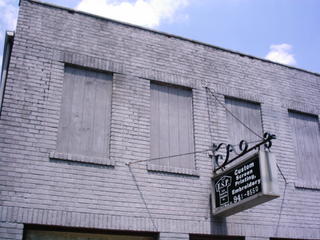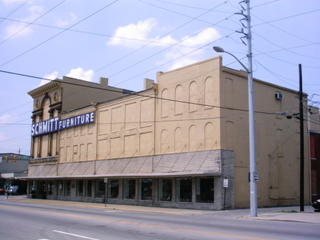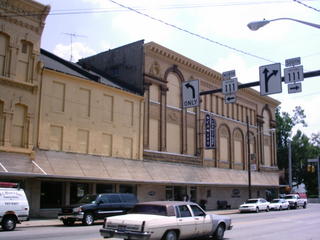(Apologies for the formatting weirdness, but I'm still learning how to position the photos. The composition page shows them one way, the preview another, and the final posting differently yet again.)
When you’re crossing the Sherman Minton Bridge from Louisville, westbound on I-64, what’s the first thing that you notice about New Albany?
It could be the abrasively tacky “for sale” sign painted across the southern side of the old antique mall building on State Street, or the veritable monument to poor taste in entertainment that is the Trinkle Dome on the riverfront.
It could be the venerable, majestic Elsby Building, or the numerous church spires, or even the Knobs on the horizon.
Maybe you notice all these things. Here’s what I notice:
It could be the abrasively tacky “for sale” sign painted across the southern side of the old antique mall building on State Street, or the veritable monument to poor taste in entertainment that is the Trinkle Dome on the riverfront.
It could be the venerable, majestic Elsby Building, or the numerous church spires, or even the Knobs on the horizon.
Maybe you notice all these things. Here’s what I notice:
No doubt you’ve heard the “broken windows” theory:
A broken pane, left un-repaired is the first indication that nobody cares, which leads to more broken windows, graffiti on the walls, littered sidewalks, abandoned buildings and ultimately in a neighborhood which surrenders to neglect, crime and decline. The simple act of repairing the window communicates to the world that somebody cares.*

A broken pane, left un-repaired is the first indication that nobody cares, which leads to more broken windows, graffiti on the walls, littered sidewalks, abandoned buildings and ultimately in a neighborhood which surrenders to neglect, crime and decline. The simple act of repairing the window communicates to the world that somebody cares.*

What about no windows at all? What does that say to the world?
Soon there will be a new complex of attractive, modern buildings at Scribner Place. The drawings I’ve seen of the YMCA building show more than a few windows.
But when will there again be windows on buildings like Schmitt Furniture, whose bulk rises from the corner of Main and State like the prow of a huge beached ship, and where there isn’t a single pane of glass above the street level?
bulk rises from the corner of Main and State like the prow of a huge beached ship, and where there isn’t a single pane of glass above the street level?
But when will there again be windows on buildings like Schmitt Furniture, whose
Understand that this isn't to single out Schmitt Furniture for abuse. It's simply that Schmitt's building is the most noticeable example of windowlessness.
* description copied from http://www.nucifora.com/art_237.html












20 comments:
Thanks for being patient while I try to figure out the formatting of the photos. It's the first time I've done this, and it has me exasperated.
About the dollar signs: Agreed.
The downtown area really is a disgrace, in large part. Especially the boarded up windows.
There are a few people and businesses downtown that have done really nice renovations. I know that Stephen Beardsley has purchased a section of buildings next to his law office that he plans to renovate. Hornblower's did a very nice job on Market Street and Tom Dudgeon's Trinity building on Pearl Street is well done.
The building that bothers me the most is the Reisz Furniture warehouse that is directly across the street from Main Street Grind and Happy's. It's owned by Schmitt Furniture, and they should be ashamed for letting this eyesore continue. I remember Mayor England once telling me it bothered him a lot, too, but that he needed to stay on good terms with Mr. Schmitt because he wanted to buy his property along the floodwall (back when the original plan, before Scribner Place, involved only cutting a hole thru the floodwall to the riverfront).
I contend that if our city administration were interested in improving all the downtown area, they could get the ball rolling. Scribner Place is a worthy project, no doubt. But it's just one piece of the pie.
On another note, Roger, now that the four of us are keeping company, I think we need a new name, something that hearkens to our progressive nature but is more catchy and less limiting than Gang of Four. How about The Mod Squad?
I think the boarded up windows might have been an attempt to make the buildings look more modern--take out the windows and paint everything the same color to make the architectural details less noticeable. They have been boarded up as long as I can remember.
Of course it also eliminated the need to maintain the windows.
Ed is right. Filling all those empty holes with historically appropriate windows will cost a fortune.
I keep hearing the Mr. Schmitt is interested in developing the Reisz building. I think 3 different people have mentioned it to me.
One of them told me he has been thinking of art studios. Wouldn't that be great?
Does anyone know Mr. Schmitt? Is there any way (other than offering to finance the project) that he could be encouraged to get something started?
I understand that a number of Southern Indiana artists have taken studios at the Mellwood Arts & Entertainment Center (a lost opportunity for NA?).
Ann: Mod Squad is great, but all those Phish people have absconded with tie-dyes imagery, and now I'm not sure I want it back.
Perhaps Mr. Schmitt is one of the many who await construction to begin on Scribner Place before committing to refurbishing the Reisz building.
I'd really like to believe this, although I'm not sure such faith is merited.
Ed - that's the way I took it.
I've heard various things about the Reisz building over the years, going back to 1996. I've heard that it's going to be artist's galleries, boutique-type shopping and most recently, Dan Coffey told me that LL Bean had expressed interest in locating a store there.
My personal opinion is that some business owners bought property years ago on the cheap, hoping one day to sell for a profit. They've done so with no intention of properly maintaining structures in the interim.
The city administration has allowed this situation to persist and worsen, by refusing to enforce building codes, thus the number of decaying buildings throughout town.
I agree withoug qualification, Ann.
I agree with the Scribner as catalyst assessment. To quote the great Dan Bern, "Everybody's waiting for the messiah". It'll be interesting over the next few years to see who renovates and who sells.
I also think the mod thing would be a lot more fun if we interpreted it as British Mod, with beatle boots, skinny ties, scooters, and lounge music.
On a more serious note, does anyone know if there are rules in place concerning downtown building facades? One thing European cities have done very well is to preserve the old facades so the streets maintain their character even if the structure behind changes. It's not unusual to see an old building front propped up while an entirely new building is built behind it.
Obviously, preserving the entire building would be the best option but, given the state of some of the buildings downtown, it may not always make the most sense. If you walk around behind the Reisz building, it ain't exactly clean lines and square corners back there. It may be an easy fix. But then again it might not ever be worth it from a purely business perspective.
There are a lot of important questions about renovation standards that need to be answered sooner rather than later.
Do the Schmitts own the smaller store fronts attached to the Reisz as well?
I'm not sure how much property the Schmitts own, but the ones I know they own(ed) are not too attractive. They owned the warehouses along the floodwall that were purchased for Scribner Place, the Reisz building, and of course their main bldg on the furniture corner of State and Main.
I know that it's possible to set and maintain certain standards for buildings, and to require that windows be functional, etc. Look at Madison's downtown. No boarded up windows there. They don't permit it.
The difference between them and us is that Madison made it a priority to preserve and restore, and they consistently go after grant money and other methods to do so.
Going back to the building codes--read them sometime. They spell out very clearly what is and isn't permitted and who is responsible for enforcement. It's usually the building commissioner, but some things may be police or health department issues.
Have any of you ever seen the building commissioner or any inspector out doing any inspections for code violations in any of the decrepit buildings around town? It doesn't happen in New Albany.
Ed, I did miss your point. I was thinking about the cost of replacing windows. I certainly agree there is lots of potential there for residential space. I think it would also work well for office space. To make those buildings profitable the upstairs space needs to be put to use somehow.
Bluegill, Downtown is one of the historic districts. Anything done to the facade of a building must be approved by the historic preservation commission to make sure it meets the guidelines in the historic preservation ordinance.
However, being in the historic district doesn't prevent a building from being torn down. I don't think there are any requirements for facades to be saved if the building is torn down.
Ann, There are zoning ordinances in place that prevent downtown buildings from being used as warehouses. Those ordinances are obviously not enforced.
If you try to fix up one of those decrepit buildings the building inspectors will be there to make you jump through hoops.
It's hard to imagine that LL Bean would locate in NA. I know that Develop New Albany would like to see chains locating downtown because they feel that independent businesses usually don't have the resources to be successful. I would like to see more support for independent businesses.
na girl hit the nail on the head. The New Albany Historic Preservation Commission approves exterior work to structures in the downtown historic district. Our job is to preserve the historic fabric of the city - assuring that work done does not detract from the existing fabric.
Regarding bluegill's inquiry into facades - every project is different. Normally, there would have to be a darn good reason to demolish a structure behind a facade and then rebuild. If a building is to far gone to save, this would be an option.
The Commission does have Design Guidelines to assist property owners in determining what is acceptable and what is not. We hope to have these available online on the city website soon. If anyone would like a copy, please just shoot me an email.
As far as the current condition of the downtown is concerned, we all know we've got some problems. But we've also got some great structures down there. Anyone I've ever taken downtown comes away impressed. Believe it or not, we are in much better shape than many other communities.
Part of the NAHPC mission is to educate and advocate. It is possible that current property owners do not know some of the tax advantages and other benefits available to them for re-habbing a historic structure. We will work to change that. Also, Commission members will be meeting with Paul Wheatley soon to discuss ways we can help him. We will make sure he has information to pass on to potential developers about the advantages of locating in our historic districts.
The city is also working towards receiving Certified Local Government status (see www.cr.nps.gov/hps/clg for more info). CLG status has many benefits, including sources for funding.
I encourage anyone interested in preservation to attend one of our meetings, the 2nd Thursday of each month on the 3rd floor of the city county building. Share your ideas with us. Help us with projects we are currently working. We'd love to hear from everyone.
Ted Fulmore
Chair, New Albany Historic Preservation Commission
I appreciate the work of the historic preservation commission, but how much bite do they really have?
It's hearsay but, while we were shopping for a house in a historic district, I was told by more than one person that it's easier to do what you want and beg for forgiveness than it is to get permission in the first place. We plan on making our house as historically correct as possible but I was taken aback by the comments.
As the downtown we envision inches closer to reality, there very well may come a time when a piece of land is worth more than the building(s) on it to developers. What then? Are they allowed to tear down what they want? And what goes up in its place? Clear guidelines or commission decision?
I can think of scenarios that would certainly tug at my own values in opposite directions.
As one of the pseudo-intellectuals, I'll spare everyone a DNA rant and suggest that I wouldn't be entirely against reevaluating their mission and worth.
Do they get financial support from the city? If so, how much?
Sorry, Ted. I didn't read your post before I hit the publish button. Thanks for the infromation.
Can you tell me, though, how much authority the commission really has? What happens when someone doesn't follow the guidelines?
Section 151.15 (Enforcement, Penalties, and Judicial Review) of the Historic Preservation Ordinance for the City of New Albany, Indiana - will give you some detail.
If you decide to not follow the ordinance you can expect the following: a letter requesting a Certificate of Appropriateness be completed and submitted as well as your presence being requested at the next Commission meeting. If the project is underway, a stop work order could be issued by the City.
After a COA is submitted, the standard review process takes place.
I find it slightly embarrassing that a neighbor would encourage you to violate a city ordinance.
Especially in light of the recent fight for an OEO.
The commission doesn't have any enforcement authority at this time. We have a delegate from the MSPA on the board (I'm currently the Vice-Chair of MSPA), and he has told me that the commission is working on getting tougher and referring non-compliance to the city atty for enforcement. So they are really trying to let people know they are serious about getting approval prior to doing work.
We should point out to DNA that those independent businesses that do survive will contribute far more to their efforts and the local economy than any chain ever will. Also, there’s a significant group of people in downtown New Albany actively choosing to support independent businesses rather than chain stores.
I've spoken csually with Paul Wheatley on a couple of occasions, and each time he's noted that his personal preference is to try and give downtown as local a flavor as possible. As we know already, and he confirms this, the biggest impediment to progress is that entrepreneurs are waiting to see girders at Scribner Place before committing.
I have been to a couple of historic preservation commission meetings and based on that I would say that it is not difficult at all to get a COA. The board takes a cooperative approach. They are very much working with the applicant rather than dictating to him/her.
I would advise anyone who owns property in one of the historic districts to attend a meeting or two to find out how it works prior to applying for a COA.
And you do have to learn to plan ahead. You can't just decide on Sat morning that you will start a project on the exterior of your property that afternoon.
Enforcement of the historic preservation ordinances for non-complying properties ultimately ends up with the city attorney. Seems that the money budgeted for attorney fees always falls short of what is actually needed.
Ordinance enforcement is a multiple step process that only begins with a codes enforcement officer.
Actually, I find it hard to believe that New Albany has historic preservation ordinances and a historic preservation commission at all. I prefer to look at this as a major step in the right direction rather than too little too late.
There have been some real historic preservation success stories recently: St Edward's Ct, Division St school, Cardinal Ritter house.
Don't forget about Historic Landmarks. We are very lucky to have the regional office in Jeffersonville. They are a great resource.
HPC needs the will to issue stop work orders before we talk about "enforcement."
HPC needs to draw a bright line on the next violator of the guidelines. "I didn't know" just won't cut it anymore.
If what I do on my property detracts from the value of yours, who pays for that? HPC is exercising "discretion" where none exists. I'm sure there are gray areas where reasonable people can debate, but in my first exposure to the commission, they had a clear violation, and forgave it.
Post a Comment